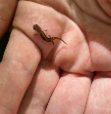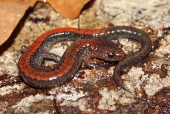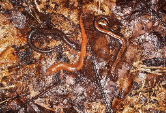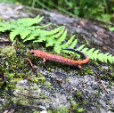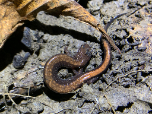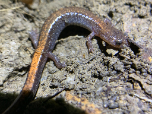Eastern Red-Backed Salamander (Plethodon cinereus)
Description: Eastern red-backed salamanders can occur in two color phases, lead-back and red-back. The lead-back phase salamanders are a consistent gray to black color while the red-back phase is characterized by an orange to red stripe down the length of their body and tail. In both phases, they are distinguishable by their mottled white and black undersides and five toes on their hind feet. They also lack lungs.
Eastern red-backed salamanders can evade predators by dropping all or part of their tail in the event of an attack. In its place, a new tail will eventually grow, though this new tail may be duller in color. Adults may reach between 2 and 5 inches (5 to 12.7 centimeters) in length.
Habitat: Due to their lack of lungs, eastern red-backed salamanders need to live in damp or moist habitats in order to breathe. They are often found in or under logs, leaf-litter and burrows of deciduous forests. In colder months, these salamanders go under the frozen ground. With a low tolerance for acidic soil, they cannot live in areas with high acidity.
Range: Eastern red-backed salamanders extend from Minnesota to North Carolina and northeastern Tennessee in the United States, and from western Ontario to southern Quebec and throughout Nova Scotia in Canada.
Diet: In the wild, eastern red-backed salamanders eat a wide variety of small invertebrates, including arachnids, worms, snails, larvae and insects. Since they only inhabit damp habitats, their foraging range is dependent on the seasons, expanding in the wet seasons and retracting in the dry seasons.
Reproduction: Males and females of P. cinereus typically establish separate feeding and/or mating territories underneath rocks and logs. However, some red-backed salamanders are thought to engage in social monogamy, and may maintain co-defended territories throughout their active periods. Breeding occurs in June and July. Females produce from four to 17 eggs in a year. The eggs hatch in 6 to 8 weeks. Not much is known about the dispersal of neonates, although neonates and juveniles are thought to be philopatric.
As in many Plethodon species, female red-backed salamanders have the ability to store sperm as spermatophore, and have been evidenced in doing so up to eight months prior to the oviposition period in June and July. Sperm or spermatophores are not retained following the oviposition period.
Status: Listed as Least Concern in view of its wide distribution and number of subpopulations, presumed large population size, and use of a wide range of habitats.
»» Kingdom: Animalia - Animals
»» Phylum: Chordata - Chordates
»» Subphylum: Vertebrata - Vertebrates
»» Class: Amphibia - (Amphibians)
»» Order: Caudata - Salamanders
»» Family: Plethodontidae - Lungless Salamanders
»» Genus: Plethodon
»» Species: Plethodon cinereus - Eastern Red-Backed Salamander
This article uses material from the Wikipedia article "Red-Backed Salamander", which is released under the Creative Commons Attribution-Share-Alike License 3.0. Content may have been omitted from the original, but no content has been changed or extended.
|


